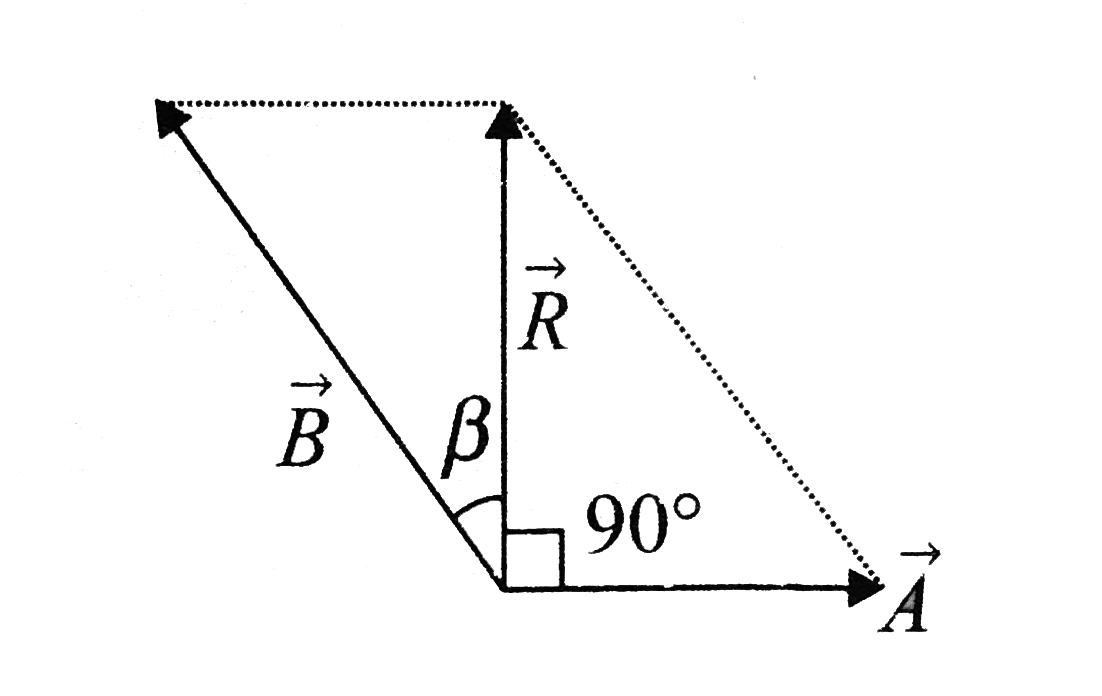Two vectors →A and →B have equal magnitudes. If magnitude of →A−→B is equal to (n) times the magnitude of →A−→B, then angle between →A and →B is ?
cos−1(n−1n−1)
cos−1(n2−1n2+1)
cos−1(n−1n−1)
cos−1(n2−1n2+1)
The correct Answer is:B
To solve the problem, we need to find the angle between two vectors →A and →B given that they have equal magnitudes and the magnitude of →A+→B is equal to n times the magnitude of →A−→B.
1. Given Information:
- Magnitude of →A is equal to the magnitude of →B.
- Let |→A|=|→B|=A.
- We have the equation:
|→A+→B|=n|→A−→B|
2. Express Magnitudes:
- The magnitude of →A+→B can be expressed using the formula:
|→A+→B|=√|→A|2+|→B|2+2|→A||→B|cosθ
- Since |→A|=|→B|=A, this becomes:
|→A+→B|=√A2+A2+2A2cosθ=√2A2(1+cosθ)=A√2(1+cosθ)
3. Magnitude of →A−→B:
- Similarly, the magnitude of →A−→B is given by:
|→A−→B|=√|→A|2+|→B|2−2|→A||→B|cosθ
- This becomes:
|→A−→B|=√A2+A2−2A2cosθ=√2A2(1−cosθ)=A√2(1−cosθ)
4. Substituting into the Equation:
- Now substituting these magnitudes into the original equation:
A√2(1+cosθ)=n⋅A√2(1−cosθ)
- Dividing both sides by A (assuming A≠0):
√2(1+cosθ)=n√2(1−cosθ)
5. Squaring Both Sides:
- Squaring both sides gives:
2(1+cosθ)=n2⋅2(1−cosθ)
- Simplifying this:
1+cosθ=n2(1−cosθ)
6. Rearranging the Equation:
- Rearranging gives:
1+cosθ=n2−n2cosθ
- Bringing all terms involving cosθ to one side:
cosθ+n2cosθ=n2−1
- Factoring out cosθ:
cosθ(1+n2)=n2−1
7. Finding cosθ:
- Finally, we can express cosθ:
cosθ=n2−11+n2
8. Finding the Angle:
- The angle θ can be found using the inverse cosine function:
θ=cos−1(n2−11+n2)
Final Answer:
The angle θ between the vectors →A and →B is given by:
θ=cos−1(n2−11+n2)
- Magnitude of →A is equal to the magnitude of →B.
- Let |→A|=|→B|=A.
- We have the equation:
|→A+→B|=n|→A−→B|
- The magnitude of →A+→B can be expressed using the formula:
|→A+→B|=√|→A|2+|→B|2+2|→A||→B|cosθ
- Since |→A|=|→B|=A, this becomes:
|→A+→B|=√A2+A2+2A2cosθ=√2A2(1+cosθ)=A√2(1+cosθ)
- Similarly, the magnitude of →A−→B is given by:
|→A−→B|=√|→A|2+|→B|2−2|→A||→B|cosθ
- This becomes:
|→A−→B|=√A2+A2−2A2cosθ=√2A2(1−cosθ)=A√2(1−cosθ)
- Now substituting these magnitudes into the original equation:
A√2(1+cosθ)=n⋅A√2(1−cosθ)
- Dividing both sides by A (assuming A≠0):
√2(1+cosθ)=n√2(1−cosθ)
- Squaring both sides gives:
2(1+cosθ)=n2⋅2(1−cosθ)
- Simplifying this:
1+cosθ=n2(1−cosθ)
- Rearranging gives:
1+cosθ=n2−n2cosθ
- Bringing all terms involving cosθ to one side:
cosθ+n2cosθ=n2−1
- Factoring out cosθ:
cosθ(1+n2)=n2−1
- Finally, we can express cosθ:
cosθ=n2−11+n2
- The angle θ can be found using the inverse cosine function:
θ=cos−1(n2−11+n2)
The angle θ between the vectors →A and →B is given by:
θ=cos−1(n2−11+n2)
Topper's Solved these Questions
- KINEMATICSBOOK - PRADEEPCHAPTER - KINEMATICSEXERCISE - 4 NCERT multiple Choice
10 Videos
- KINEMATICSBOOK - PRADEEPCHAPTER - KINEMATICSEXERCISE - 4 NCERT Integer type
4 Videos
- KINEMATICSBOOK - PRADEEPCHAPTER - KINEMATICSEXERCISE - 2 NCERT multiple
15 Videos
- GRAVIATIONBOOK - PRADEEPCHAPTER - GRAVIATIONEXERCISE - Assertion-Reason Type Questions
19 Videos
- LAWS OF MOTIONBOOK - PRADEEPCHAPTER - LAWS OF MOTIONEXERCISE - Assertion- Reason Type Questions
17 Videos
Similar Questions
Two vectors →Aand→B have equal magnitudes.If magnitude of (→A+→B) is equal to n times of the magnitude of (→A−→B) then the angle between →Aand→B is :-
View SolutionTwo vectors vec A and vec B have equal magnitudes.The magnitude of (vec A+vec B) is 'n' times the magnitude of (vec A-vec B).The angle between vec A and vec B is:
View Solution
Knowledge Check
Two vector →Vand→V have equal magnitudes. If magnitude of →A+→B is equal to n time the magnitude of →A−→B, then angel to between →Aand→B is
Acos−1(n−1n+1)Bcos−1(n2−1n2+1)Csin−1(n−1n+1)Dsin−1(n2−1n2+1)The resultant of two vectors →Aand→B is perpendicular to the vector →A and its magnitude is equal to half the magnitude of vector →B. What is the angle between →Aand→B ?
A30∘B45∘C150∘D120∘Two vector →A and →B have equal magnitudes. Then the vector →A+→B is perpendicular :
A→A×→BB→A−→BC3→A−3→BDAll of these
The resultant of two vectors →Aand→B perpendicular to the vector →Aanditsmagnitudequal→halfofthemagnitudeofthe→−−→r vec B.F∈doutthe∠between vec A and vec B.
View SolutionThe resultant of two velocity vectors →A and →B is perpendicular to →A. Magnitude of Resultant →R is equal to half magnitude of →B. If the angle between →A and →B is (30θ)∘, then value of θ is ?
View SolutionTwo vectors →A and →B have precisely equal magnitudes. For the magnitude of →A+→B to be larger than the magnitude of →A−→B by a factor of n, what must be the angle between them?
View SolutionIf magnitudes of vectors →A,→Band→C are 5, 4 and 3 units respectively and →A=→B+→C, then angle between →Aand→B is
View SolutionThe resultant of two vectors →A and →B is perpendicular to the vector →A and its magnitudes is equal to half of the magnitudes of vector →B (figure). The angle between →A and →B is

View Solution
